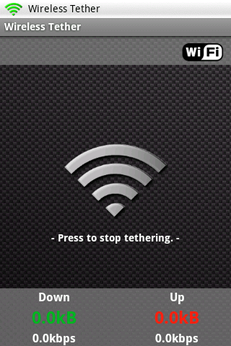Turn Your (Rooted) Android Device into a WiFi Hotspot with Wireless Tether

Productivity Sauce
There are two ways to turn your Android phone into a mobile wireless hotspot: you can either buy a device running Android 2.2 Froyo, or you can root your current Android phone and install the Wireless Tether application. I did the latter, and rooted my HTC Magic using the Amon Ra's Clear Donut ROM which includes Wireless Tether. True, rooting an Android device is not particularly straightforward, and there is a risk of bricking the device in the process, but it's really worth it. Having a mobile wireless hotspot in your pocket can come in handy in many situations, especially when you travel abroad. In some countries like Germany, you can buy a daily pass which offers unlimited data connection for a reasonable price. This means that you don't have to pay through the nose for wonky hotel WiFi, and you can access the Internet on the go.
Despite its apparent simplicity, Wireless Tether is a rather competent tool. It allows you to specify the desired SSID name, turn SSID broadcasting on and off, enable encryption (albeit it supports only 128-bit WEP), and select the channel you want. Better yet, you can enable the access control feature, so you can prevent unwanted connections. Using Wireless Tether is ridiculously easy. Launch the app, and press the big Tether button. A handy status bar at the bottom displays the amount of downloaded and uploaded data. And that pretty much covers Wireless Tether's features.
There are, of course, other ways to tether Android devices, but they are all limited in one way or another. So if you are not afraid of rooting your phone, then you ought to give Wireless Tether a try.
Comments
comments powered by DisqusSubscribe to our Linux Newsletters
Find Linux and Open Source Jobs
Subscribe to our ADMIN Newsletters
Support Our Work
Linux Magazine content is made possible with support from readers like you. Please consider contributing when you’ve found an article to be beneficial.

News
-
TuxCare Announces Support for AlmaLinux 9.2
Thanks to TuxCare, AlmaLinux 9.2 (and soon version 9.6) now enjoys years of ongoing patching and compliance.
-
Go-Based Botnet Attacking IoT Devices
Using an SSH credential brute-force attack, the Go-based PumaBot is exploiting IoT devices everywhere.
-
Plasma 6.5 Promises Better Memory Optimization
With the stable Plasma 6.4 on the horizon, KDE has a few new tricks up its sleeve for Plasma 6.5.
-
KaOS 2025.05 Officially Qt5 Free
If you're a fan of independent Linux distributions, the team behind KaOS is proud to announce the latest iteration that includes kernel 6.14 and KDE's Plasma 6.3.5.
-
Linux Kernel 6.15 Now Available
The latest Linux kernel is now available with several new features/improvements and the usual bug fixes.
-
Microsoft Makes Surprising WSL Announcement
In a move that might surprise some users, Microsoft has made Windows Subsystem for Linux open source.
-
Red Hat Releases RHEL 10 Early
Red Hat quietly rolled out the official release of RHEL 10.0 a bit early.
-
openSUSE Joins End of 10
openSUSE has decided to not only join the End of 10 movement but it also will no longer support the Deepin Desktop Environment.
-
New Version of Flatpak Released
Flatpak 1.16.1 is now available as the latest, stable version with various improvements.
-
IBM Announces Powerhouse Linux Server
IBM has unleashed a seriously powerful Linux server with the LinuxONE Emperor 5.


?????